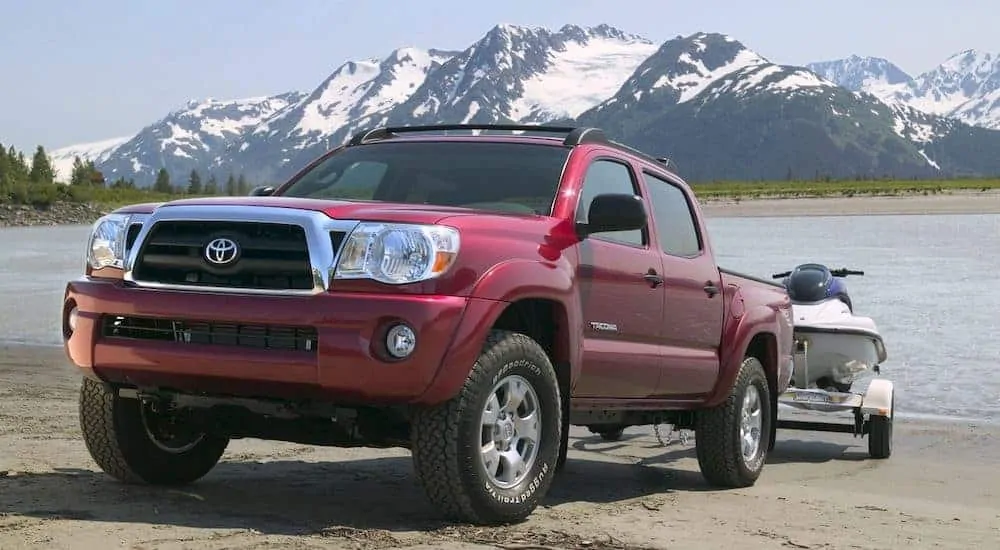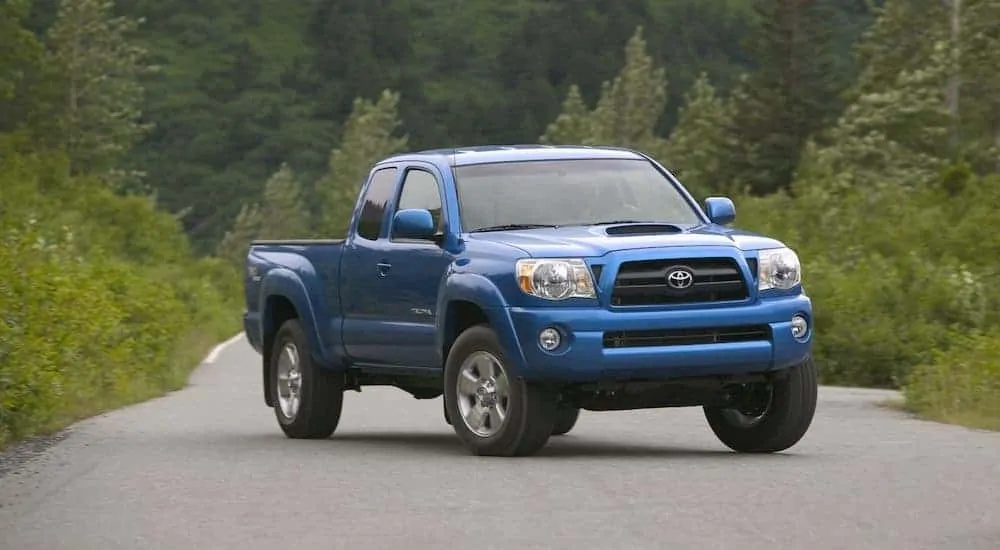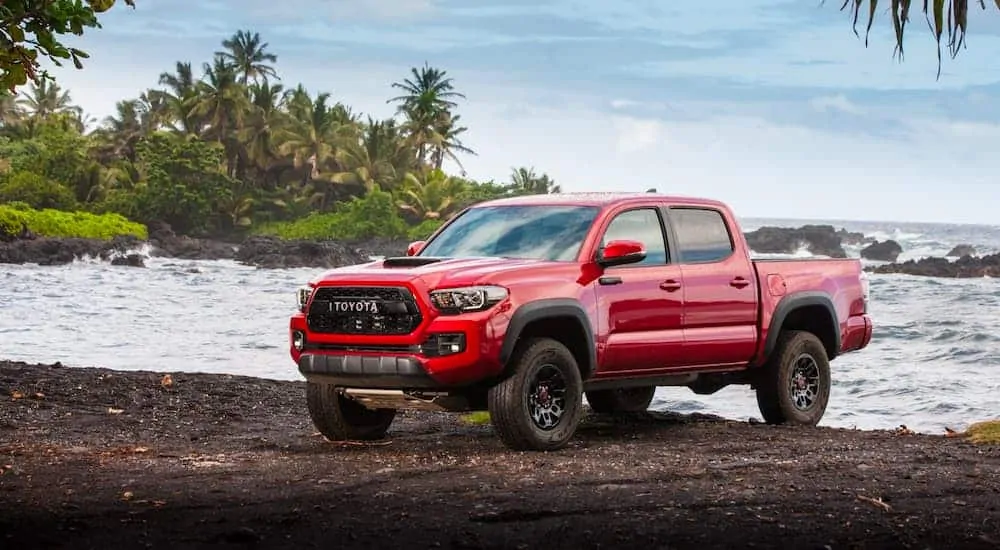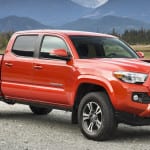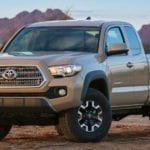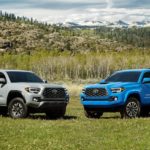If you’re like me, you can see the benefits of buying a light-duty truck. You get the payload and towing capabilities of a pickup truck without having to handle the size issues of a full-size or heavy-duty pickup. Light-duty trucks are easier to handle, no hassle finding a parking spot, and still have plenty of room for whatever you need to haul. One of my favorite light-duty trucks is the Toyota Tacoma, and if you want a great deal, you should consider finding one that is used. A used Toyota Tacoma gives you the ability to buy a lot of truck while giving you a vehicle that is reliable, dependable, and fun to drive.
This is especially the case if you are into off-roading as Toyota has been selling the trail-ready Tacoma TRD Off-Road since the 1998 model year. That means that you should find plenty of TRD Off-Road models available when you go out to buy your used Toyota Tacoma. However, before you run out that door and head over to your used Toyota dealer, you’re going to want to know the background on the Tacoma so you can choose the one that is just right for you.
Three Generations of Tacoma
Toyota introduced the Tacoma for the 1995 model year, and that truck became such a hit they didn’t change a thing with it until the 2005 model year and the introduction of the second-generation Tacoma. That first-generation model had three different configurations as well as three different engine options, two choices of transmission, and came rear-wheel drive standard with four-wheel drive available as an option. As previously mentioned, the TRD Off-Road was introduced in the 1998 model year and was only available in four-wheel drive. It had many items to make it ideal for off-roading, including larger wheels and tires and a choice of rear-locking differential or limited slip differential.
Not wanting to simply rest on its laurels, Toyota decided to make some significant upgrades on the Tacoma for the 2005 model year. The grille got a facelift, giving it a more aggressive profile. The truck was also lifted a few inches, giving it higher road clearance than the first-generation model. The second generation came with three choices of cab, two engine options, and four different transmission choices. The Tacoma continued to be rear-wheel drive standard with available four-wheel drive. This second generation Tacoma was just as popular as the original version and carried on for an entire decade.
The 2016 model year saw the introduction of the third-generation Tacoma, which continues to be built to this day. This continued the tradition of rugged good looks introduced with the second generation in 2005. The third generation added a stiffer frame and an improved suspension system. The two engine options were continued for the 2016 model with a choice of three transmissions and two cab designs. We will explore these differences further below.
Choice of Configurations for Your Tacoma
One of the most confusing things about truck designs is that each manufacturer seems to have its own name for the different types of cabs. Toyota is no different. Like most automakers, Toyota refers to the two-door cab with one row of seats as a Regular Cab. Now, this is where things get a little confusing. For Toyota, a cab with two rows of seats and four full-size doors is referred to as the Double Cab. If you are not confused yet, then hold onto your seat.
For the first generation of the Tacoma, Toyota called the cab with two-rows of seats, two full-size doors, and two-half doors the Xtracab. Once the public got used to that unique name, Toyota decided to change things for the second generation of the Tacoma. The new name for this cab design is the Access Cab, which Toyota thankfully decided to keep for the third generation of the Tacoma. So, if you see the name Xtracab, you know it is a first-generation Tacoma, while the name Access Cab can mean either a second or third-generation model.
The other key difference between the generations is that Toyota discontinued the Regular Cab on the third generation of the Tacoma. Therefore, if you want a Tacoma with just one row of seats, then your best bet is to find a used first or second-generation truck. The Regular Cab comes with a long payload bed regardless if it is a first or second-generation model.
This is not the case with the Double Cab and Xtracab/Access Cab. With each of these cab designs, you have a choice between a standard bed for more payload capacity and a short bed for improved towing capacity. The reason why a short bed improves towing capacity is because anything that increases the gross vehicle weight of your truck, such as four-wheel drivetrains and longer payload beds, will reduce the amount of trailer that your truck can haul. So, if you want the maximum trailer capacity, you will have to choose a Tacoma Xtracab or Access Cab with rear-wheel drive.
Engine Options on the Tacoma
The first generation Tacoma has a choice of three engines. The most common is a 2.7-liter I-4 gas engine that produces up to 150 horsepower and 177 lb-ft of torque. This engine is very efficient with an estimated fuel economy of 16 MPG in the city, 20 MPG on the highway, and a combined 18 MPG. You are most likely to find this on a used Tacoma Regular Cab.
The first generation also featured a larger 3.4-liter V6 gas engine that produces 190 horsepower and 220 lb-ft of torque. This improved the power of the Tacoma, especially with respect to towing. It also was highly efficient, with rear-wheel drive models getting an estimated 17 MPG in the city, 20 MPG on the highway, and a combined 18 MPG. If you find a four-wheel drive model, the mileage will still be good with 15 MPG city, 18 MPG highway, and 16 MPG combined. The final engine option was a 2.4-liter I-4 with 142 horsepower and 160 lb-ft of torque. However, this was underpowered and not very popular, so you are unlikely to find a used Tacoma with this third engine option.
The first generation Tacoma also gave drivers a choice of either a 5-speed manual transmission or a 4-speed automatic transmission. Unless you feel comfortable with a stick, you should make sure your used Tacoma has an automatic transmission before closing the deal.
Responding to the marketplace, Toyota reduced the number of engine options to two for the second generation. The base engine is a 2.7-liter I-4 that is an improvement over the one used on the first-generation model with more power and fuel efficiency. It produces 164 horsepower and 183 lb-ft of torque, and drivers with a rear-wheel drive Tacoma can expect fuel economy of 18 MPG in the city, 25 MPG highway, and 20 MPG combined.
The other engine option is a 4.0-liter V6 that produces 245 horsepower and 282 lb-ft of torque. Despite its power, this engine won’t hurt you at the pump with 16 MPG city, 21 MPG highway, and a combined 18 MPG. The second-generation Tacoma also gave drivers a choice of four different transmissions, a 4-speed automatic, a 5-speed automatic, a 5-speed manual, and a 6-speed manual. If you are buying a second-generation Tacoma, you need to make sure the model you’re looking at has the transmission you desire.
With the third-generation Tacoma, Toyota eased back on the throttle a little bit but improved overall fuel economy. The 2.7-liter I-4 was carried over but with slightly less strength: 159 horsepower and 180 lb-ft of torque. Drivers with a rear-wheel drive Tacoma can expect 19 MPG city and 23 MPG highway for a combined 21 MPG. Those with 4-wheel drive will feel a slight pinch on fuel efficiency of 19 MPG in the city and 22 MPG on the highway for a combined 20 MPG.
The 3.5-liter V6 in the third generation Tacoma introduced variable valve timing with an Atkinson cycle to both increase fuel economy while giving it increased efficient performance. This V6 produces 278 horsepower and 265 lb-ft of torque. Rear-wheel drive Tacomas with the V6 engine are estimated to provide 19 MPG city and 24 MPG highway for a combined 21 MPG. Four-wheel drive models will get an estimated 18 MPG in the city and 23 MPG on the highway for a combined 20 MPG.
Towing and Cargo Capacities on the Tacoma
The capabilities of the Tacoma have been something that has evolved over time. The first generation models had a maximum towing capacity of 5,000 pounds of trailer on Xtracab and Double Cab models and maximum payload capacity of 1,810 pounds on the Regular Cab. The trailering capabilities improved with the second generation, which has a maximum towing capacity of 6,500 pounds and a maximum payload capacity of 1,650 pounds.
The top model for towing has to be the third generation, which can tow up to 6,800 pounds while having a maximum payload capacity of 1,620 pounds. Therefore, if you are looking for towing, then the third generation would be your best bet, while a first-generation Regular Cab Tacoma will give you the best payload capacity for this truck.
The used Toyota Tacoma is your best option if you are in the market for a light-duty truck that is anything but light. Whether you choose a third-generation Tacoma for its ability to tow trailers, a first-generation model for its payload capacity, or a TRD Off-Road from any of the three generations because you love to hit the trails, a used Tacoma will put you in the driver’s seat in deciding what truck best serves your purposes.
